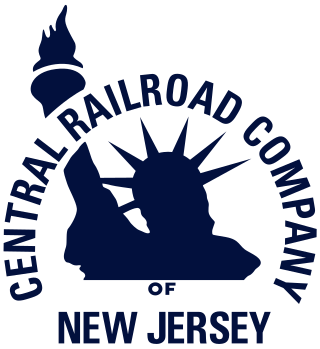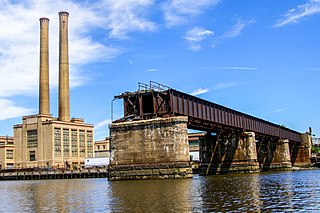
NJ Transit Rail Operations is the rail division of NJ Transit. It operates commuter rail service in New Jersey, with most service centered on transportation to and from New York City, Hoboken, and Newark. NJ Transit also operates rail service in Orange and Rockland counties in New York under contract to Metro-North Railroad. The commuter rail lines saw 57,179,000 riders in 2023, making it the third-busiest commuter railroad in North America and the longest commuter rail system in North America by route length.

The Central Railroad of New Jersey, also known as the Jersey Central, Jersey Central Lines or New Jersey Central, was a Class I railroad with origins in the 1830s. It was absorbed into Conrail in April 1976 along with several other prominent bankrupt railroads of the Northeastern United States.

For the purposes of this article, the Jersey City area extends North to Edgewater, South to Bayonne and includes Kearny Junction and Harrison but not Newark. Many routes east of Newark are listed here.

A moveable bridge, or movable bridge, is a bridge that moves to allow passage for boats or barges. In American English, the term is synonymous with drawbridge, and the latter is the common term, but drawbridge can be limited to the narrower, historical definition used in some other forms of English, in which drawbridge refers to only a specific type of moveable bridge often found in castles.

The Central Railroad of New Jersey Terminal, also known as Communipaw Terminal and Jersey City Terminal, was the Central Railroad of New Jersey's waterfront passenger terminal in Jersey City, New Jersey. The terminal was built in 1889, replacing an earlier one that had been in use since 1864. It operated until April 30, 1967.

The Raritan Bay Drawbridge, also known as River-Draw, Raritan Bay Swing Bridge, and Raritan River Railroad Bridge, is a railroad swing bridge crossing the Raritan River 0.5 miles (0.8 km) from where it empties into the Raritan Bay in Middlesex County, New Jersey, United States. It crosses the city line of Perth Amboy to the north and South Amboy to the south.

On September 15, 1958, a Central Railroad of New Jersey (CNJ) morning commuter train, #3314, ran through a restricting and a stop signal, derailed, and slid off the open Newark Bay lift bridge in Newark Bay, New Jersey, United States. Both diesel locomotives and the first two coaches plunged into Newark Bay and sank immediately, killing 48 people and injuring 48 more. A third coach, snagged by its rear truck (bogie), hung precariously off the bridge for two hours before it also toppled into the water. As the locomotive crew was killed, the cause of the crash was never proven, though the lack of a "dead man's switch" may have contributed to the derailment.

The New York and Greenwood Lake Railway owned a line between Croxton, Jersey City, New Jersey and Greenwood Lake, New York. Service on the line was provided by the Erie Railroad.

The Upper Bay Bridge, or the Lehigh Valley Railroad Bridge, is a vertical lift bridge spanning the Newark Bay in northeastern New Jersey. It is used by CSX Transportation travelling through the North Jersey Shared Assets Area of the United States rail network along the National Docks Secondary line. The bridge is just north and parallel to the New Jersey Turnpike's Newark Bay Bridge. A notable train using the bridge is the Juice Train, which originates in Florida.

The Newark and New York Branch was a railway line that ran between Downtown Newark and the Communipaw Terminal at the mouth of the North River in Jersey City, bridging the Hackensack River and Passaic River just north of their mouths at the Newark Bay in northeastern New Jersey. The Central Railroad of New Jersey operated it from its opening in 1869. Through operations ended in 1946; portions remained in use until 1967.

The NX Draw is an out-of-service railroad bridge on the Passaic River between Newark and Kearny, New Jersey. It is the 13th bridge from the river's mouth at Newark Bay and is 6.5 miles (10.5 km) upstream from it. The bascule bridge, built by the Erie Railroad and once part of its Newark Branch, has been abandoned in the raised position.

WR Draw is an out-of-service railroad bridge crossing the Passaic River between Newark and the Arlington section of Kearny, New Jersey. The plate girder rim-bearing swing bridge, originally built in 1897 and modified in 1911 and 1950, is the 14th bridge from the river's mouth at Newark Bay and is 8.1 miles (13.0 km) upstream from it. Last used for regular passenger service in 2002, it is welded in closed position as its height is not considered a hazard to navigation.
The Newark Branch was a branch of the Erie Railroad in New Jersey, United States, running between Jersey City and Paterson and passing through the Broadway Section in North Newark, the origin of its name. Inaugurated in the 1870s, the line was last used for passenger service on September 30, 1966, but continues to be used for freight service on a portion of its length.

The PD Draw is a partially dismantled railroad bridge on the Passaic River between Newark and Kearny in the US state of New Jersey. It was built as part of Central Railroad of New Jersey line known as the Newark and New York Branch. The swing bridge is the first crossing upstream from Newark Bay at mile point 1.2.

The Newark Drawbridge, also known as the Morristown Line Bridge, is a railroad bridge on the Passaic River between Newark and Harrison, New Jersey. The swing bridge is the 11th bridge from the river's mouth at Newark Bay and is 5.85 miles (9.41 km) upstream from it. Opened in 1903, it is owned and operated by New Jersey Transit.

Point-No-Point Bridge is a railroad bridge crossing the Passaic River between Newark and Kearny, New Jersey, United States, in the New Jersey Meadowlands. The swing bridge is the fourth from the river's mouth at Newark Bay and is 2.6 miles (4.2 km) upstream from it. A camelback through truss bridge, it is owned by Conrail as part of its North Jersey Shared Assets and carries the Passaic and Harsimus Line used by CSX Transportation and Norfolk Southern. River Subdivision accesses the line via Marion Junction. Conrail is replacing the bridge, which was opened in 1901. Work began in November 2022.

The Lincoln Highway Passaic River Bridge is a vehicular moveable bridge crossing the Passaic River at a point 1.8 mi (2.9 km) from the river mouth at Newark Bay in northeastern New Jersey, United States. The vertical lift bridge, along the route of the Lincoln Highway, carries U.S. Route 1/9 Truck and the East Coast Greenway between the Ironbound section of Newark and Kearny Point in Kearny. Opened in 1941, it is owned by and operated by the New Jersey Department of Transportation (NJDOT) and required by the Code of Federal Regulations to open on 4-hour notice for maritime traffic.

Newark Broad Street station was a railway terminal in Newark, New Jersey at the western end of the Newark and New York Branch of the Central Railroad of New Jersey. The station was located on Broad Street, near Four Corners. It was approximately 2,500 feet (760 m) west of the Pennsylvania Railroad's Newark Penn Station and 1 mile (1.6 km) south of the Delaware, Lackawanna and Western Railroad's Newark Broad Street station. The building was constructed in 1917, replacing an earlier structure. The station closed in 1967 as part of the Aldene Plan. The Prudential Center arena occupies most of the site. The head house on Broad Street remains and is contributing property of the Four Corners Historic District.


















